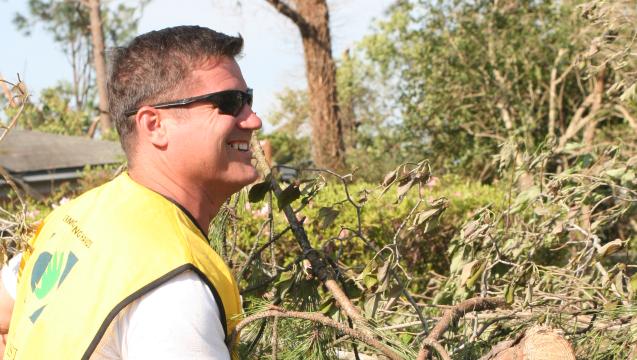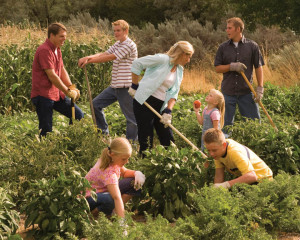A University of Pennsylvania professor, with a team of researchers, has released a new study that shows Mormons volunteer more and give more to charity than do other Americans. The study was done by Ram Cnaan, who is the Associate Dean for Research, Professor, and Chair of the Doctoral Program in Social Welfare and the Director of the Program for Religion and Social Policy Research at the University of Pennsylvania. Professor Cnaan is a highly respected expert on the subject of faith-based social services and the author of a forthcoming book on the role of churches in helping urban Philadelphia.
 The study showed that the average American donates 48 hours per year to charitable works. Active Mormons donate an average of 427.9 hours per year, with 151.9 of those hours dedicated to the Church’s community and social initiatives, including Boy Scouts and humanitarian work. The church’s humanitarian organization is non-sectarian. They volunteer about 34 hours a year in programs non-Mormon programs.
The study showed that the average American donates 48 hours per year to charitable works. Active Mormons donate an average of 427.9 hours per year, with 151.9 of those hours dedicated to the Church’s community and social initiatives, including Boy Scouts and humanitarian work. The church’s humanitarian organization is non-sectarian. They volunteer about 34 hours a year in programs non-Mormon programs.
Mormon congregations are completely operated by volunteers. Even the bishop, similar to a pastor, is a volunteer. Since he does have other employment and a family, everyone pitches in to make things run. This is done through callings, volunteer positions assigned through prayerful decision making by leaders. Callings are frequently rotated, giving members many opportunities to learn new skills, many of which transfer to employment skills. Mormons teach classes, lead organizations, oversee humanitarian work, teach literacy, operate Boy Scout troops and assist others in finding work, for instance.
In another study, Cnaan noted that it did not matter whether religious social services are provided to the congregation only or if they are open to the community as a whole, since the church is still providing services the government or others would have to provide otherwise. Congregants are still members of the community. A Mormon who receives assistance from a food bank just for Mormons does not have to take resources from other food banks or from government food programs, leaving those resources for others who do not have a congregation to provide it.
Mormons provide a wide range of services. Some are designed for church members and some serve others without regard to religion.
Each month, Mormons are asked to fast for twenty-four hours—a complete fast that does not allow for any type of food or drink. This is done if the person can safely do so and requires the person to skip two meals. The money that would otherwise have been spent on food is donated to a special program known as Fast offerings. This fund is administered to members of the congregation who have short term temporal needs. The church operates Bishop’s Storehouses, which are similar to food banks. Although they are only for Mormons, they make it possible for Mormons to not take from other community food resources. The storehouse provides everything the member needs to survive—food, cleaning supplies, hygiene items, and baby care products. While most community food banks can only provide a shopping bag of food for two weeks, requiring those in need to visit several sources, the storehouse provides everything. This is possible only because they serve a smaller clientele. The person in need first meets with a church leader to evaluate the family’s budget and to be certain they have done everything they can to reduce their costs. Church assistance is not designed to help people maintain their previous lifestyle. Then they are given a list of products available and they select what they need. The order is reviewed and approved or altered by the church leader and the person goes to the storehouse, where volunteers assist him in filling his order. The person, if possible, stays to volunteer for an hour prior to filling his own order. Food that is left over at the food bank is donated to community food banks and the church’s canneries often donate their canneries for other hunger relief organizations to use.
This, in fact, is one aspect of the program that is somewhat unique. Members who receive assistance are asked to volunteer time to help others in need or to serve the church in order to “pay” for their assistance. The work is not enough to cover the actual cost, but by contributing to the program, the person is able to maintain a sense of self-esteem and a feeling of self-sufficiency. Although they do not receive a paycheck, their volunteerism contributes to the greater good and often means those in need are helping others equally in need.
In addition to these congregational programs, Mormons operate a humanitarian foundation that serves people worldwide and is not religious in nature. Services are provided to anyone who needs them and often to entire communities. In 2011, the Mormon humanitarian aid program spent 22 million dollars in emergency aid, not including the labor of thousands of volunteers who did the work. Many who lived in disaster areas found hundreds of Mormon volunteers show up in yellow Helping Hands shirts or vests, prepared to do whatever needed to be done. Contributions in disaster areas continue long after the media has moved on to new stories. In addition, the program operates ongoing assistance in areas such as neonatal resuscitation, vaccinations, clean water, wheelchair donations, and literacy. Retired couples often volunteer to leave their comfortable homes to lead humanitarian aid programs in developing nations without pay.
Of course, not all programs are ongoing. Besides the various volunteer programs open to Mormons through their church, there are also innumerable acts of service done each day by individuals—a meal dropped by, child care, checking on an elderly person, or help learning to use a computer. There are also occasional projects, such as a group of children or adults making blankets for the homeless, knitting booties for infants in shelters, and creating hygiene kits for those in disaster areas.
Charitable organizations need funding in order to operate, even when they use volunteer labor. Mormons donate large portions of their income to charity. 88 percent of active Mormons pay ten percent of their income in tithing, as required by the Bible. However, in addition to this, the average Mormon also donates $1,171 dollars a year to non-Mormon charities and an additional 650 dollars a year to the church’s social welfare program.
The study stated that overall, Mormons are the most pro-social members of American society and are very generous with both time and money.
What motivates Mormons to be what the report calls the most pro-social members of society? Mormons, a nickname given to members of The Church of Jesus Christ of Latter-day Saints, are taught to follow the example of Jesus Christ, who was always looking for ways to serve those to whom He ministered.
In October 2009, Thomas S. Monson, the current Mormon prophet, gave a talk to teenagers called “The Joy of Service.” President Monson is noted for his passion for service, having been raised during the Depression by parents who were always serving their neighbors and feeding the hungry who came to their door. As a young married man in his early twenties, he was called to be a bishop over a congregation that included eighty widows. His congregation was very poor and needed tremendous looking after, which he did with love and unselfishness.
President Monson said:
As we look heavenward, we inevitably learn of our responsibility to reach outward. To find real happiness, we must seek for it in a focus outside ourselves. No one has learned the meaning of living until he has surrendered his ego to the service of his fellow man. Service to others is akin to duty, the fulfillment of which brings true joy. We do not live alone—in our city, our nation, or our world. There is no dividing line between our prosperity and our neighbor’s wretchedness. “Love thy neighbor” is more than a divine truth. It is a pattern for perfection. This truth inspires the familiar charge, “Go forth to serve.” Try as some of us may, we cannot escape the influence our lives have upon the lives of others. Ours is the opportunity to build, to lift, to inspire, and indeed to lead. The New Testament teaches that it is impossible to take a right attitude toward Christ without taking an unselfish attitude toward men:
“Inasmuch as ye have done it unto one of the least of these my brethren, ye have done it unto me” (Matthew 25:40).
We may think as we please, but there is no question about what the Bible teaches. In the New Testament there is no road to the heart of God that does not lead through the heart of man. The Prophet Joseph Smith taught that a true Latter-day Saint “is to feed the hungry, to clothe the naked, to provide for the widow, to dry up the tear of the orphan, to comfort the afflicted, whether in this church or in any other, or in no church at all, wherever he finds them” (Times and Seasons, Mar. 15, 1842, 732).”
This sermon reaches to the heart of Mormonism and helps to explain what the researchers found. It is a religion that focuses on love, service, and compassion for others.
Mormon Volunteerism Highlighted in New Study
About Terrie Lynn Bittner
The late Terrie Lynn Bittner—beloved wife, mother, grandmother, and friend—was the author of two homeschooling books and numerous articles, including several that appeared in Latter-day Saint magazines. She became a member of the Church at the age of 17 and began sharing her faith online in 1992.





